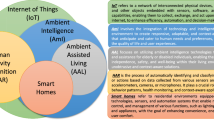Abstract
One of the main challenges in the smart-phone world is that they are battery constrained and the development of battery technologies have not kept pace with the required energy demand. In particular, there are still significant technological gaps on developing energy-aware solutions that would prolong the battery life of devices without affecting the quality of the distributed video/multimedia content. In this aspect, this paper proposes DE-BAR—a process based innovation that will provide a seamless battery saving mechanism, based on backlight and adaptive region of interest of the streamed multimedia content. This work intends to look at the nature of the video/multimedia content that is received in the device and adapts the energy consumption dynamically at three levels: Screen Colour, backlight and Intensity; and adaptive Region-of-Interest (RoI) based variation in the multimedia content. Notably, the work provides the mechanism for real-time adaptation. The colour intensity, number of RoI for the video sequence and the frame rate is decided by the spatial and temporal complexity of the video. The energy consumption is measured using an Arduino board while video quality is analyzed using extensive subjective tests. The results indicate that more than 50% energy could be saved in the device while retaining above average perceptual video quality.
















Similar content being viewed by others
References
Venkataraman, H., Wu, T., Bi, T., & Muntean, G.-M. (2015). DEAR: An energy-centric adaptive region-of-interest mechanism for mobile devices. In 18th IEEE international conference on wireless personal and multimedia communications (WPMC), December 13–16, 2015.
Venkataraman, H., Wang, S., & Muntean, G.-M. (2015). EDAS: Energy-efficient device-based adaptive cross-layer scheme for wireless multimedia transmission. In 18th IEEE international conference on wireless personal and multimedia communications (WPMC), December 13–16, 2015.
http://www.fedoroffsoft.com/. Last Accessed December 12, 2016.
www.mobimonster2.com. Last Accessed November 24, 2016.
http://www.xphonesoftware.com/pm.html. Last Accessed December 8, 2016.
http://www.faqs.org/patents/app/20080281803. Last Accessed December 8, 2016.
http://www.faqs.org/patents/app/20100016035. Last Accessed August 21, 2017.
http://www.faqs.org/patents/app/20100098138. Last Accessed December 17, 2016.
http://www.faqs.org/patents/app/20090278774. Last Accessed March 23, 2017.
U.S. Patent No. 6,999,800. (2012). Method for power management of a smart phone, under litigation with Apple.
US Patent No. 7716505. Power control methods for a portable electronic device. http://www.google.com.pg/patents/US7716505.
Apple, USPTO, No. 5920726. System and method for managing power conditions within a digital camera device. https://patentpia.com/patent/evaluation?id=US00005920726B&locale=US.
USPTO, No. 20150248118 A1. Systems and methods for modeling energy consumption and creating demand response strategies using learning-based approaches. https://www.google.ch/patents/US20150248118.
Reingold, E. M., & Loschky, L. C. (2000). Reduced saliency of peripheral target in gaze-contingent multi-resolution displays: Blended v/s sharp boundary windows. In Proceedings of eye-tracking research & applications symposium, New Orleans, USA.
Watson, B. A., Walker, N., Hodges, L. F., & Warden, A. (1997). Managing level of detail through peripheral degradation: effects on search performance with a head-mounted display. ACM Transactions on Human-Computer Interaction, 4(4), 323–346.
Lee, J. H., & Yo, C. (2011). Scalable RoI algorithm for H.264/SVC-based video streaming. IEEE Transaction on Consumer Electronics, 57(2), 357–365.
Ciubotaru, B., Muntean, G.-M., & Ghinea, G. (2009). Objective assessment of region of interest-aware adaptive multimedia streaming quality. IEEE Transactions on Broadcasting, 55(2), 202–212.
Ciubotaru, B., Ghinea, G., & Muntean, G.-M. (2014). Subjective assessment of region of interest-aware adaptive multimedia streaming quality. IEEE Transactions on Broadcasting, 60(1), 50–60.
Venkataraman, H., Addanki, S. C., Vinodh, B., & Assfalg, R. (2016) Analysis of region-of-interest (RoI) of multimedia content using eye-tracker. In 17th international ACM MobiHoc conference, Paderborn, Germany, July 3–6, 2016.
ITU-T. (2016). Methods for the subjective assessment of video quality, audio quality and audiovisual quality of internet video and distribution quality television in any environment. Recommendation P.913.
Kennedy, M., Hadjadj Aoul, Y., Ksentini, A., & Muntean, G.-M. (2013). Adaptive energy optimization in multimedia-centric wireless devices: A survey. IEEE Transactions on Survey and Tutorials, 15(2), 768–786.
Trestian, R., et al. (2012). Quality utility modeling for multimedia applications for android mobile devices. In IEEE international symposium on broadband multimedia systems and applications (BMSB), Seoul, Korea.
Carroll, A., & Heiser, G. (2010). An analysis of power consumption in a Smartphone. In USENIXATC’10 proceedings of the 2010 USENIX conference on USENIX annual technical conference, Boston, MA, USA, June 23–25, 2010.
Trestian, R., et al. (2012). Energy consumption analysis of video streaming to android mobile devices. Hawaii: IEEE Network Operations and Management System (NOMS).
Kennedy, M., Venkataraman, H., & Muntean, G.-M. (2011). Battery and stream-aware adaptive multimedia delivery for wireless devices. Denver: IEEE Local Computer Networks (LCN).
Author information
Authors and Affiliations
Corresponding author
Rights and permissions
About this article
Cite this article
Venkataraman, H., Bi, T., Wu, T. et al. DE-BAR: Device Energy-Centric Backlight and Adaptive Region of Interest Mechanism for Wireless Mobile Devices. Wireless Pers Commun 100, 351–377 (2018). https://doi.org/10.1007/s11277-017-5076-4
Published:
Issue Date:
DOI: https://doi.org/10.1007/s11277-017-5076-4




